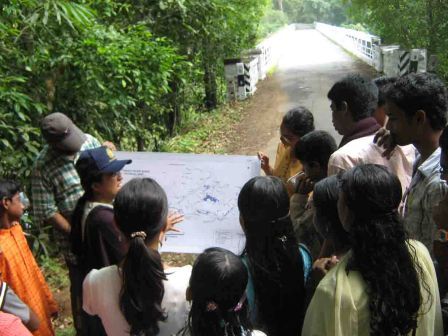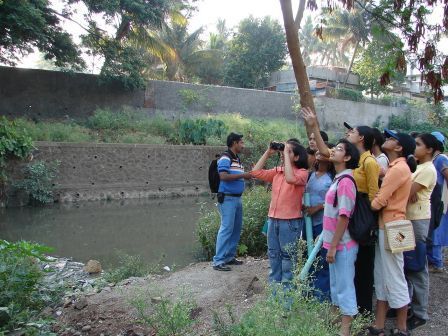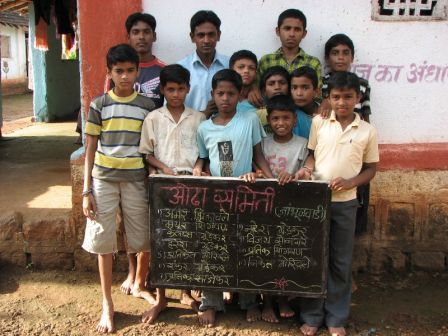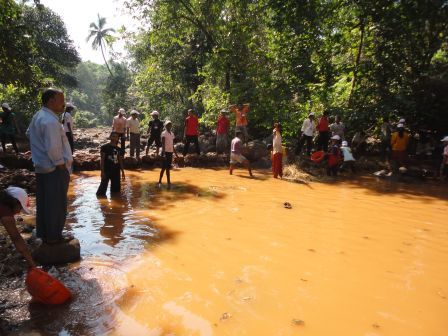 Above - Children studying a map of the Chalakudy Basin. Photo - RRC.
Above - Children studying a map of the Chalakudy Basin. Photo - RRC.
Seeds of sustainability and sensitivity when sown at a young age, blossom into responsible individuals. And you need to be in touch with the land to sow those seeds. The Central and State Boards of Education in India have made Environmental Science a compulsory subject for schools and junior colleges (for all subjects). But Environmental Sciences is not to be studied in the classroom. In order to understand the erosion and deposition processes of a river, students need to visit a river bend in their city and in order to instil a lifelong aversion to plastic bags, a landfill and dumping grounds need to be seen.
However, many students, lucky enough to be residing near beautiful rivers and forests are now getting a chance to study the entire riverine ecosystem, its interconnections, and the after effects of dams and diversions with experts who work on these rivers. This is an attempt of show casing some of these inspiring initiatives around the country and if the readers are aware of more such efforts, we would be glad to feature them.
Schools for Rivers, River Research Centre, Kerala - The RRC started its ongoing ‘Schools for Rivers’ program in August 2009, with an aim of sensitizing the students about rivers and river conservation. Six schools and more than a hundred students have participated in the program, which includes classroom lectures, treks and a 3-day river camp, where the students get a chance to study and celebrate their river.
During the latest River Camp to Valparai in the Anamalai Hills via the Chalakudy – Anamalai forest road, students travelled along the length of river Chalakudy, which is threatened by the Athirappilly Hydroelectric Project on the famous Athirappilly falls. The students could see for themselves Athirappilly falls, Athirappilly dam site, Vazachal tribal settlement, proposed site for tribal relocation, etc. During the camp, students also organised a road campaign to help stop the accidental deaths of Lion Tailed Macaques (an endangered species of monkeys, endemic to the Western Ghat Forests) that cross the hill roads. The fall out of this activity has been that the Forest Department and River Research Centre, with the help of schools working in this Program, are holding such student campaigns on Saturdays and Sundays wherein the students talk with the travellers about driving with care in the forest section and banning the use of plastic.
Rustic Valley Tours, Gomukh Trust, Pune:
 Above - Students exploring urban streams in Pune.
Above - Students exploring urban streams in Pune.
Gomukh Trust, Pune has been organising River interaction camps for students since the past nine years. These ‘Rustic Valley Tours’ take the students on a journey to the origin of Rivers Mula, Mutha in the Mulshi valley and River Bhima at Bhimashanker. From here, students get to see the different facets of the river, its uses to different communities, the habitats it provides for different species and the impact of growing anthropogenic pressures on its fragile balance. Students have their breakfast and lunch in a local village, providing income to a local family. A local guide is hired, who is also a student and she shares the wonders of her village and her river with her city friends. Through a single river trip, an entire Chapter on river ecology, pollution control, aesthetics, social sciences, history and mythology is experienced.
Nirmal Ganga Abhiyaan, Ecological Society, Pune and Konkan:
 Above - Students Stream Monitoring Committee at Wavoshi Village Photo - Amol Gajewar
Above - Students Stream Monitoring Committee at Wavoshi Village Photo - Amol Gajewar
 Above - Students observing their stream and structures Photo - Amol Gajewar
Above - Students observing their stream and structures Photo - Amol Gajewar
In 2007, The Ecological Society, Pune announced a competition for villages in Maharashtra, to draw up a plan for ecological restoration of their streams or rivers. What started as a competition turned into a vibrant process of stream restoration which was spearheaded by schools from nearly nine villages. The program began with an introduction to stream and river ecosystems and led to practical restoration work including bank stabilisation, creation of riparian corridors, construction of loose boulder structures, making check lists of stream assessment in dry and wet regions, evolving a unique environment education campaign with the participating schools and students. Most of the fieldwork is currently being done by students and while working with the experts, they are also learning interesting things about their stream, ecology, agriculture, social sciences, etc.
Desilting the River Gholap, Ratnagiri:
Perhaps the most dramatic tale of students working for rivers has been witnessed by village Gholap in the Ratnagiri District, Maharashtra. The village consists of 24 waadis or settlements with a population of 3500 and a small river ‘Gholap’ flows through the village for about 14 kilometres. Due to continuous erosion from the surrounding hill slopes and the intrinsic nature of lateritic basalt found in konkan, the river bed has been heavily silted and the 7 Kolhapur type weirs along the river now hold only silt.
 Above - The silted Gholap River and weir before and after desilting Photo - G-J College
Above - The silted Gholap River and weir before and after desilting Photo - G-J College
On 26th December, 2010, around 870 students volunteering for the National Service Scheme (NSS) from the states of Rajasthan, Gujarat, Madhya Pradesh, Karnataka, Goa, Diu Daman and Andhra Pradesh came to this village of Gholap for their year-end camp. They were initially viewed with suspicion and unease as it was difficult to accommodate such a large number of students in the Waadis and the villagers were not sure of what exactly the students could achieve.
On the 27th morning, students entered the river and started taking out silt manually. Hundreds of ‘paatis’ (buckets) of silt was removed from the river bed. On the 27th evening, the first KT Wier on the upstream was cleaned completely. And miraculously, by the next evening, it was brimming with water.
 Above: A group of students desilting the river Photo: G-J College
Above: A group of students desilting the river Photo: G-J College
Looking at the increasing water level (and also the huge quantiy of silt), a charitable trust hired two JCBs to help the students in desilting. Groups consisting of 60-70 students each worked on the entire stretch of the river to clear the clogging aquifers. By the time the students finished their job, the river and the weirs had ample water in them. Water levels rose in wells near the river. After witnessing that the efforts of the students are leading to dramatic rise in water levels of wells, villagers also pitched in and nearly 1200 people in total worked on the Gholap River for 6 days, to remove more than 500 truckloads of silt.
According to Dr. Surendra Thakurdesai, Professor of Geography and NSS coordinator for Gogate-Joglekar College, water levels in the downstream wells increased by an average of 1.5 feet in these 7 days. Entire stretch of the river, which earlier held very little water in intermittent puddles, became a flowing river again. So much so that in order to desalt the downstream weirs, students actually had to build 9 temporary stone weirs across the river to contain the water and complete their work. Traditional Irrigation channels made along the river, criss-crossing the riparian fields also started flowing.
Some of the silt was deposited on the lateritic plateaus of the village and has been secured with small impoundments built around it. Many dumper-loads of silt was also deposited in private fields and farms of the villagers. Students carried out bank stabilisation and pitching works for which considerable silt was used. Through the Shri Charitable Trust (a Trust based in Mumbai, working in the Pawas area where the shrine of Swamy Swarupanand is located) a part of this silt was transported along the Ratnagiri-Pawas Road and was used for tree plantation.
Mr. Ulhas Paranjpe of the Jalvardhini Pratishthan, Karjat, trained students the basics of watershed management, for example, a simple contour marker was made on site, by making an equilateral triangle using three sticks, with a stone suspended from an apex. Similarly, the students learned to calculate river flow simply by floating a leaf in one of the irrigation channel and measuring the cross section of the channel and distance covered by the leaf in one minute.
The entities which made this happen were the Gogate-Joglekar College, Ratnagiri through the National Service Scheme (This College was the official host of the NSS group), Shri Charitable Trust from Ratnagiri, which has been working on plantations and rural employment generation activities around Ratnagiri and Orange County Foundation. As the work progressed, villagers and tourists also chipped in.
According to Vilas Gogate of the Orange County Foundation, students who had to skip their baths in the first couple of days due to water shortage in the village, actually swam in the river waters on the last day. There cannot be a stronger and a more lasting lesson on watershed management, river restoration or community participation than this. Students who experience such initiatives will carry the seeds of hope and possibility with them wherever they go.
With more such initiatives happening in our schools, colleges and universities, the future does look bright.
Also published in Dams, Rivers and People, Jan 2011 Issue
/articles/river-schools-can-make-future-look-bright-parineeta-dandekar